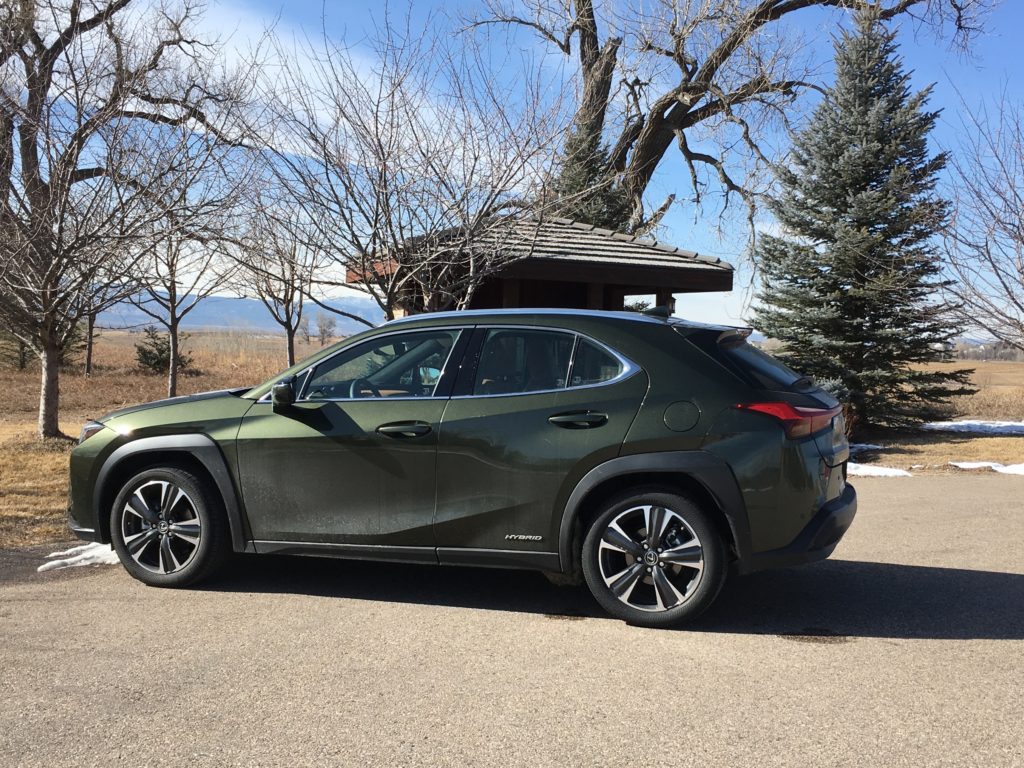
It’s an odd-color green on the 2019 Lexus UX 250h all-wheel-drive review model I piloted in February. Nori green pearl, Lexus calls it, somewhat like the olive green on a Jeep.
This is no Jeep. It is Lexus’ new luxury subcompact SUV, a hybrid which gains AWD capability through use of an electric motor-generator which drives the rear wheels. It is based on the platform of the fun-but-quirky-looking Toyota C-HR, which showed up a year ago.
The Japanese-built UX will battle for sales in the luxury subcompact category against such strong entries as the Audi Q3, BMW X2, Cadillac XT4, Infiniti QX30, Jaguar E-Pace, Mercedes-Benz GLA-Class, Range Rover Evoque and Volvo XC40.
The UX 250h all-wheel-drive model is powered by a 2.0-liter, 4-cylinder gas engine, an electric motor up front and another at the back, where also is a nickel-metal hydride battery pack. The motor at the rear is the source of power to the rear wheels, as there is no driveshaft. The electric motor-generator drives the rear wheels up to 45 miles per hour, and beyond that the UX performs in front-drive. The gas/electric power sources are tied to a continuously variable transmission.
The hybrid addition lifts the UXh’s estimated fuel mileage to 41 in town and 38 on the highway. My overall average was 33.2, reduced some by two mornings of driving in 8-below-zero temperatures.
The new subcompact is also offered in nonhybrid form as the Lexus UX200, a front-wheel-drive vehicle with a 169-horsepower, 4-cylinder gas engine. The UX250h, with its gas/electric combination, is rated at 181 horsepower. Its electric boost off the line makes it quicker than the nonhybrid model.
The UX250h is small, with a 103.9-inch wheelbase and overall length of 177 inches, yet because of the battery pack and electric motors it carries a hefty 3,605-pound curb weight. It rides on Bridgestone 225/50RF18 tires.
Space is very tight in the rear cargo area; only 17 cubic feet, short of the 19-24 range of its luxury subcompact competitors. I realized how short when our load of supplies from Costco in Timnath had to be divided between the cargo and rear seats. It’s the battery pack and a sloped roofline that steal away space, for the non-hybrid version of the UX has available more cubic feet than the hybrid.
Golden leatherette-finished seats (heated and cooled) and dash pads embellished the interior. Some difficulty arose with use of the remote touch controller for infotainment, though the simple and quick-response voice command eased the situation. A couple of interior “bugs” I’ve complained about in other Lexus models are the “ears” protruding from each side of a cover atop the gauge panel. They’re dials for snow/traction and for shifting between comfort and sport modes and seem out of place. These are key decision choices for a driver while maneuvering; of absolutely no concern to other passengers, and ought to be more unobtrusively placed.
The Lexus UX250h shows a relatively reasonable base price of $34,000. Add to that navigation and premium sound system, triple-beam LED headlamps, cornering lamps, blind-spot monitor, rear cross-traffic alert with braking, moonroof and heated steering wheel, and the sticker total reaches $42,050.
Lexus now has a full line of SUV/crossovers. The lineup and starting prices include, at the top, the large LX at $86,080; the GX at $52,355; the RX Hybrid at $46,095; the RX at $43,670; the NX Hybrid at $38,835; the NX at $36,485; the UX Hybrid at $34,000; the UX at $32,000.